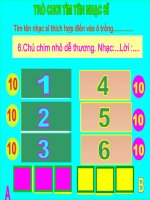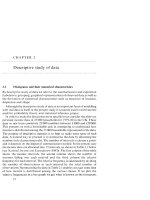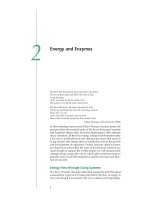Slide international ficance chapter 2
Bạn đang xem bản rút gọn của tài liệu. Xem và tải ngay bản đầy đủ của tài liệu tại đây (2.37 MB, 40 trang )
International Finance
#2. Chapter 2: The balance of payments
By Nguyen Cam Nhung
1
CuuDuongThanCong.com
/>
Objectives
To learn two essential tools to understand
macroeconomic linkages between countries.
(1) National Income Accounting:
◦ A useful tool to understand the cause of business cycle
of an economy.
◦ Without this tool, we cannot say anything about which
kind of policy response we should use to a particular
recession or boom of the economy.
2
CuuDuongThanCong.com
/>
Objectives (cont’d)
(2) Balance of Payments:
◦ An important analytical tool when we consider the
external relationship of a country concerned.
Questions:
◦ The US has recorded huge amount of trade deficits for
the last several decades. Is it sustainable?
◦ Without the understanding of the balance of payments
as well as the national income accounting, we cannot
answer the above question.
3
CuuDuongThanCong.com
/>
Case Study 1: Trade Friction
between Japan and the US
Background:
◦ Japan records large amounts of trade surplus to the
World, especially to the US, for the last few decades.
◦ The yen/dollar exchange rates appreciated sharply
from 1985.
◦ But, Japan’s trade surplus did not decline. It actually
increased from 1984 to 1987.
4
CuuDuongThanCong.com
/>
Trade Friction between Japan and the
US (cont’d)
The US government wanted to reduce the trade
deficit against Japan in the 1980s.
In 1985, G7 countries agreed to the depreciation
of the US dollar (“Plaza Accord”).
Did the depreciation of the US dollar surely
reduce the trade deficit against Japan?
◦ No. (See Figures)
◦ Why US trade deficits did not decline even after a sharp
depreciation of the dollar?
5
CuuDuongThanCong.com
/>
Two different views
1) Exchange rate works for the adjustment of trade
account imbalances.
◦ But, as Figures show, exchange rates did not work well
for such adjustments
2) Trade surplus/deficit is determined by the
saving and investment relationship of a country
concerned.
◦ Need to understand the National Income Accounting.
6
CuuDuongThanCong.com
/>
Balance of Payments
Questions:
◦ Why is a government typically concerned about a large
current account deficit (or surplus)?
◦ How does the US finance its large amount of trade deficit?
◦ The US has not been in danger of repaying its foreign debt
even though it continues to record large amount of trade
deficits. In contrast, developing economies often get into
danger in repaying foreign debts and suffer from capital
fight, if they have large trade deficits for several years.
Why?
7
CuuDuongThanCong.com
/>
Balance of Payments (BOP)
A balance of payments accounts keep track of both a
country’s payments to and its receipts from foreigners.
◦ Debit (-): a negative sign
payment.
◦ Credit (+): a positive sign
in a receipt from foreigners.
any transaction resulting in a
any transaction resulting
Rule of double-entry bookkeeping:
◦ Every international transaction automatically enters the
balance of payments twice, once as a credit and once as a
debit.
8
CuuDuongThanCong.com
/>
Three types of transactions
recorded in BOP (1)
1. Current account:
◦ Transaction that involve the export or import
of goods or services.
How
to record the transactions:
◦ Debit (-): importing goods and services
Payment to foreigners.
◦ Credit (+): exporting goods and services
Receipt from foreigners.
9
CuuDuongThanCong.com
/>
Three types of transactions
recorded in BOP (2)
2. Financial account:
◦ Transactions that involve the purchase or sale
of financial assets (e.g. FDI, portfolio
investment, international bank loans, etc).
How
to record the transactions:
◦ Debit (-): importing (purchasing) assets.
◦ Credit (+): exporting (selling) assets.
10
CuuDuongThanCong.com
/>
Three types of transactions
recorded in BOP (3)
3. Capital account:
◦ Certain other activities resulting in transfers
of wealth between countries.
◦ E.g. The US government forgives $1 billion
in debt owed to the government of the
Philippines. The US wealth declines by $1
billion, which is recorded as debt in the US
capital account.
11
CuuDuongThanCong.com
/>
Example 1 of paired transactions
Credit
Car purchase
Current account
Debit
- USD 20,000
(US good import)
Sale of bank
Financial account
deposit
(US asset export)
+ USD 20,000
◦ Example 1: US residents buy an automobile from Toyota
with a USD 20,000 cheque.
Toyota’s US salesperson deposits the check in Toyota’s
account at Citibank in US.
Toyota has received (imported), and Citibank has exported a
US asset (cheque).
12
CuuDuongThanCong.com
/>
Example 2 of paired transactions
Cred it
Vietnam p urchase
Financial acco unt
of a MS share
(US asset exp o rt)
US d ep osit of
Financial acco unt
Vietnam payment
(US asset impo rt)
Deb it
+ USD 1 millio n
- USD 1 millio n
Example 2: Vietnamese resident purchases a newly issued share
of stock in Microsoft (MS) with a USD 1 million cheque.
◦ Vietnamese acquisition of the MS stock create a USD 1 million
credit in the US financial account.
◦ Vietnamese resident has exported, and the US bank (Citibank) has
imported, a Vietnamese asset (cheque).
13
CuuDuongThanCong.com
/>
Balance of Payments Accounts
The
fundamental Balance of Payments
Identify:
◦ Current Account + Financial Account + Capital Account
=0
A
detailed description of the balance of
payments accounts:
◦ Must
see
Table
12-2
in
Krugman
Obstfeld, International Economics: Theory
Policy, Seventh Edition, 2006, p.295.
&
and
14
CuuDuongThanCong.com
/>
Table 12-2: US balance of payments
accounts for 2003 (billions of USD)
Current Account
Capital Account
Financial Account
1) Exports
2) Imports
3) Net unilateral transfers
Balance on C.A. (= 1+ 2+ 3)
4)
5) US assets held abroad
6) Foreign assets held in US
Balance of F.A (= 5+ 6)
Statistical discrepancy
Credit
+ 1,314.9
Debit
-1,778.1
-67.4
-530.7
-3.1
-283.4
+ 829.2
+ 545.8
-12.0
15
CuuDuongThanCong.com
/>
Statistical Discrepancy
Definition:
◦ The sum of (i) current account balance, (ii) capital account
and (iii) financial account balance, with opposite sign.
Why the sum is not equal to zero given the rule of
double-entry bookkeeping?
◦ Information about the offsetting debit and credit items
associated with a given transaction may be collected from
different sources.
◦ It is notoriously difficult to keep track of the complicated
financial transactions (i.e. financial account) between
residents of different countries.
16
CuuDuongThanCong.com
/>
Official Reserve Transactions
Definition:
◦ The purchase or sale of official reserve assets by central bank
Official international reserves:
◦ Foreign assets (mainly US dollar assets) held by central banks
as a cushion against national economic misfortune.
Official foreign exchange intervention:
◦ Central banks often buy or sell international reserves in
private asset markets to affect macroeconomic conditions in
their economies.
17
CuuDuongThanCong.com
/>
Example 3 of paired transactions
Credit
US purchase of a
Current account
Germany car
(US good import)
Bundesbank buys
Financial account
$ assets
(US asset export)
Debit
- USD 1 million
+ USD 1 million
Example 3: A US auto dealer imports a car from Germany, and
Bundesbank purchases a US $ 1 million cheque from German car
seller.
◦ German car seller receives a US $ 1 million cheque from US auto
dealer. Bundesbank buys the cheque in exchange for German money
◦ Bundesbank’s international reserves rise by US $ 1 million.
18
CuuDuongThanCong.com
/>
Official Reserve Transactions (cont’d)
Balance of Official Reserve Transactions:
◦ US balance of ORT = (i) – (ii)
◦ (i) = The net increase in foreign official reserve claims on
the US
◦ (ii) = The net increase in the US official reserves.
◦ See Table 12-2.
$250.1 billion (= $248.6+$1.5)
balance is the US BORT in 2003.
19
CuuDuongThanCong.com
/>
Official Reserve Transactions (cont’d)
Official Settlements Balance:
(= Balance of Payments)
◦ The bookkeeping offset to the balance of official reserve
transactions (ORT).
◦ It indicates the payment gap that official reserve
transactions need to cover.
◦ See Table 12-2. $250.1 billion balance is to measure the
degree to which monetary authorities in USA and abroad
joined with other lenders to cover the US current account
deficit.
20
CuuDuongThanCong.com
/>
Table: Calculating the US Official Settlements
Balance for 2003 (USD billion)
Credit
Current Account
Capital Account
Non-reserve F.A.
Official reserve
transactions (ORT)
1)
2)
3)
4)
5)
Balance on current account
Balance on capital account
Balance on N.F.A
Statistical discrepancy
Official settlements balance
(= Balance of Payment)
(= 1+ 2+ 3+ 4)
6) US official reserve assets held
abroad (increase - )
7) Foreign official reserve assets
held in US (increase + )
Balance of ORT (= 6 + 7)
Debit
-530.7
-3.1
+ 295.7
-12.0
-250.1
+ 1.5
+ 248.6
+ 250.1
16
21
CuuDuongThanCong.com
/>
Official Reserve Transactions (cont’d)
Official Settlements Balance:
◦ It played an important historical role as a measure of
disequilibrium in international payments, and for many
countries it still plays this role.
◦ E.g. A negative official settlements balance (a deficit)
may signal a crisis (If a country continues to run a deficit
for years), because it means that a country is running
down its international reserve assets or incurring debts to
foreign monetary authority. (See the above Table).
22
CuuDuongThanCong.com
/>
GDP Components
GDP is generally divided into 4 different types of
expenditure.
◦ Y = C + I + G + (EX – IM)
Y = GDP
C = Consumption
I = Investment
G = Government purchases
EX – IM = CA = Current account balance
The difference between export of goods and services and
imports of goods and services.
Current account surplus: EX > IM.
Current account deficit: EX < IM.
23
CuuDuongThanCong.com
/>
National Income Identity: Saving and
Current Account
National saving (S)
◦ A portion of output (Y) that is not devoted to household
consumption (C) or government purchase (G).
◦ S=Y–C–G
Modified national income identity:
◦ Y = C + I + G + CA
◦ (Y – C – G) = I + CA
◦ S = I + CA
24
CuuDuongThanCong.com
/>
National Income Identity: Saving and
Current Account (cont’d)
Implication 1:
◦ (S – I) = CA
◦ A country’s current account balance is identically
equal to national saving minus investment.
◦ E.g. If a country’s saving rate is quite high
and, hence, national saving always exceeds
investment, the country has a current account
surplus.
25
CuuDuongThanCong.com
/>









